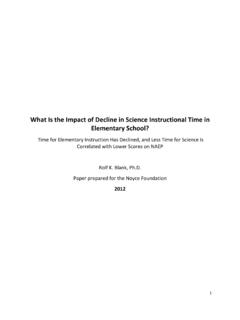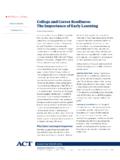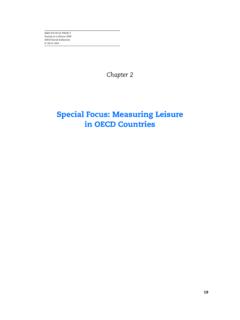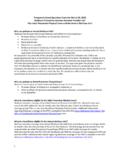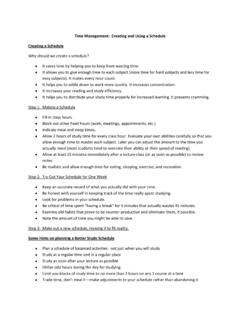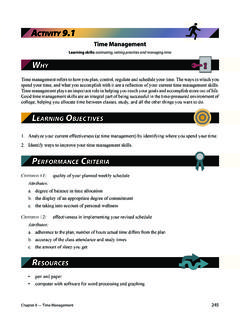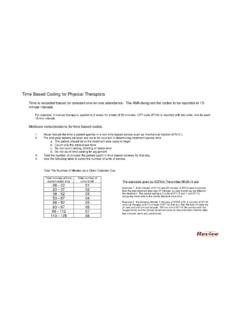Transcription of EDUCATION INDICATORS INFOCUS 22 - OECD.org
1 EDUCATION . INDICATORS . IN FOCUS 2014 (April). 22. EDUCATION data EDUCATION evidence EDUCATION policy EDUCATION analysis EDUCATION statistics How much time do primary and lower secondary students spend in the classroom? Students in OECD countries are expected to receive a total of 7 751 hours of instruction on average during their primary and lower secondary EDUCATION the bulk of that time is compulsory. In general, the higher the level of EDUCATION , the greater the number of instruction hours a year. Reading, mathematics and science take up around 50% of the compulsory curricular time in primary EDUCATION but only 40% at the lower secondary level. The wide variation in instruction hours across OECD countries suggests there is little consensus on the most effective policies related to school time . Classroom hours vary significantly between countries In OECD countries, the average total intended instruction time throughout primary and lower secondary EDUCATION is 7 751 hours, but this figure conceals significant variation between countries.
2 Formal instruction- time requirements range from 6 054 hours in Hungary to 10 710 hours in Australia. During these hours, schools offer instruction in compulsory and, if applicable, non-compulsory subjects. However, the share of non-compulsory time is relatively limited (Figure 1). Figure 1. Number of intended instruction hours in public institutions (2011). Instruction time : Primary Compulsory Non-compulsory Instruction time : Lower secondary Compulsory Non-compulsory Hungary Estonia Russian Federation Korea Czech Republic1. Slovenia Poland Sweden2. Finland Austria Belgium (Fl.). Turkey3. Greece Slovak Republic Indonesia Japan Germany Italy Belgium (Fr.). OECD average3. Norway England (UK). Denmark Chile Canada Mexico Portugal France Israel Iceland Luxembourg Spain Netherlands Ireland Australia 0 2 000 4 000 6 000 8 000 10 000 12 000. Total number of intended instruction hours Note: Intended instruction time refers to the number of hours per year which public regulations require that students receive instruction.
3 The compulsory curriculum refers to the amount and allocation of instruction time that almost every public school must provide. The non-compulsory part of the curriculum refers to the average time of instruction to which students are entitled beyond the compulsory hours of instruction. 1. Minimum number of hours per year. 2. Estimated minimum number of hours per year because breakdown by age is not available. 3. Turkey is not included in the average. Countries are ranked in ascending order of the total number of intended instruction hours. Source: OECD (2013), EDUCATION at a Glance 2013: OECD INDICATORS , indicator D1 ( ). EDUCATION INDICATORS in Focus April 2014 OECD 2014 1. EDUCATION INDICATORS in focus EDUCATION data EDUCATION evidence EDUCATION policy EDUCATION analysis EDUCATION statistics In OECD countries, primary students should receive an average of 802 hours of intended instruction time per year. Only in Australia, Canada, Chile, the French Community of Belgium, Israel, Luxembourg, the Netherlands and Portugal does it exceed 900 hours.
4 Lower secondary pupils should receive on average 122 more hours of intended instruction per year than primary students. The difference exceeds 200 hours in the Czech Republic, Finland, France, Hungary, Korea and Mexico. Reading, writing and literature, along with mathematics and science, take up half the primary compulsory curriculum The time devoted to subjects in the primary and lower secondary curriculum varies across OECD countries (Figure 2), but some patterns can be detected. At both levels of EDUCATION , around three-quarters of the learning time is devoted to six subjects: reading, writing and literature; mathematics; science; social studies; modern foreign languages and arts. Figure 2. Allocation of instruction time to subjects in the compulsory curriculum of primary and lower secondary EDUCATION , OECD average (2011). Primary compulsory curriculum Lower secondary compulsory curriculum Other, 5% Compulsory Compulsory flexible Other, 4% flexible Practical and curriculum, curriculum, vocational skills, 1% 6% Practical and Reading, writing vocational skills, 1% 7%.
5 And literature, 16%. Technology, 1% Reading, writing and literature, 26% Technology, 3%. Religion, 4%. Religion, 3%. Physical EDUCATION , 9% Physical Mathematics, 13%. EDUCATION , 8%. Arts, Arts, 11% 8%. Mathematics, 17% Science, Modern foreign 12%. Modern foreign languages, languages, 6% Social Science, 14% Social studies, studies, 7% 12%. 7%. Source: OECD (2013), EDUCATION at a Glance 2013: OECD INDICATORS , indicator D1 ( ). In primary EDUCATION , around 50% of compulsory curricular time is focused on the subjects of reading, writing and literature; mathematics; and science. Some countries devote less time to these, with 38%. of time spent on these subjects in Germany and 40% in Iceland, while others devote much more (the three subjects comprise 77% of the primary curriculum in Mexico). Reading, writing and literature is the subject given the most priority (on average one-quarter of the time ) in primary EDUCATION . Primary students spend over one-third of their time on this subject in Mexico (35%), France (37%) and Hungary (38%).
6 Modern foreign languages, science and social studies play a greater role at lower secondary level At the lower secondary level, the subject emphasis begins to change. While the average time spent on reading, writing and literature decreases from 26% to 16%, the teaching of modern foreign languages increases from 6% to 14%. Similarly, most countries dedicate at least twice more time to maths than to science in primary EDUCATION but by lower secondary level the portion of time spent on both subjects becomes more equal. Again, the actual proportions vary, with some countries continuing to focus more on maths ( Flemish community of Belgium, Italy) while others spend more time on science ( Estonia and Finland). 2 OECD 2014 EDUCATION INDICATORS in Focus April 2014 EDUCATION INDICATORS in Focus EDUCATION data EDUCATION evidence EDUCATION policy EDUCATION analysis EDUCATION statistics Arts and physical EDUCATION continue to have a place in the compulsory curriculum.
7 Relatively little time is devoted to technology In OECD countries, the arts curricula tend to focus on visual arts, music, theatre and dance (Winner et al., 2013). time spent on the arts ranges between 5% and 20% of the compulsory curriculum in primary EDUCATION . Most OECD. countries allocate less time for it in lower secondary EDUCATION , but there are some exceptions such as Austria. Arts are often offered as elective subjects in lower secondary EDUCATION , so some students may actually study more arts in the higher grades. Physical EDUCATION has a fairly consistent allocation in primary and lower secondary EDUCATION in OECD. countries (9% in primary and 8% in lower secondary). time for technology is relatively small at both levels (1% in primary and 3% in lower secondary). However, technology is given more curriculum time in a few countries such as Chile (7% in primary), Italy and England (United Kingdom) (7% and 13% in lower secondary respectively).
8 Further, technology could be used as a tool for learning in other subjects, even if not allocated as a specific subject in the compulsory curriculum. The length of the school year also varies significantly between countries Countries need to decide not just the number of instruction hours but the way in which they are distributed over the school year and school day to maximise learning outcomes. A school day which is too long may leave struggling students little time to catch up, whereas the same total hours distributed over more weeks of school offer greater flexibility over the organisation of the school day and could enable individual support sessions to be given at more productive times. In some countries, the number of weeks of teaching is shorter than the average, giving students more time -intensive school days ( Belgium, Canada, France, Iceland, Ireland, Luxembourg and Spain); in other countries ( Australia, Italy and the Netherlands), a similar number of hours are distributed over more weeks of school, which means a less intensive school day (Figure 3).
9 The huge variation across countries on both dimensions in Figure 3, and their weak correlation, suggest that there is little consensus among countries on what the evidence says about the most effective policies related to instruction time . Figure 3. Annual number of intended instruction hours and number of weeks of teaching per year in primary EDUCATION (2011). Average number of hours of total intended instruction time per year 1 050. Chile 1 000. Israel Australia Belgium (Fr.) Netherlands 950 Canada Luxembourg Portugal 900 Spain Italy France Turkey 850 Ireland Iceland Belgium (Fl.) England (UK) Mexico 800. Greece Austria Japan 750 Norway Poland Germany Denmark 700. Estonia Finland Slovak Slovenia 650 Republic Hungary Korea 600. Czech 550 Republic 500. Russian Federation 450. 34 36 38 40 42. Number of weeks of teaching per year Source: OECD (2013), EDUCATION at a Glance 2013: OECD INDICATORS , INDICATORS D1 and D4 ( ). EDUCATION INDICATORS in Focus April 2014 OECD 2014 3.
10 EDUCATION INDICATORS in focus EDUCATION data EDUCATION evidence EDUCATION policy EDUCATION analysis EDUCATION statistics Students may also spend additional time studying outside of school, for different purposes While it is instructive to reflect on the amount of time devoted to learning in schools, the time spent on study outside of school should also be taken into account. This study can be in the form of homework, extra-curricular activities and additional lessons outside of school (OECD, 2013c). However, no clear link has been shown between academic achievement and time spent in after-school lessons and individual study. For example, supplementary study time outside of school is not common in Finland, one of the highest performers in EDUCATION . On the other hand, students in Japan and Korea spend many hours in private after- school programmes drilling and practising, and these countries often have high results in international achievement tests compared with many other OECD countries.










